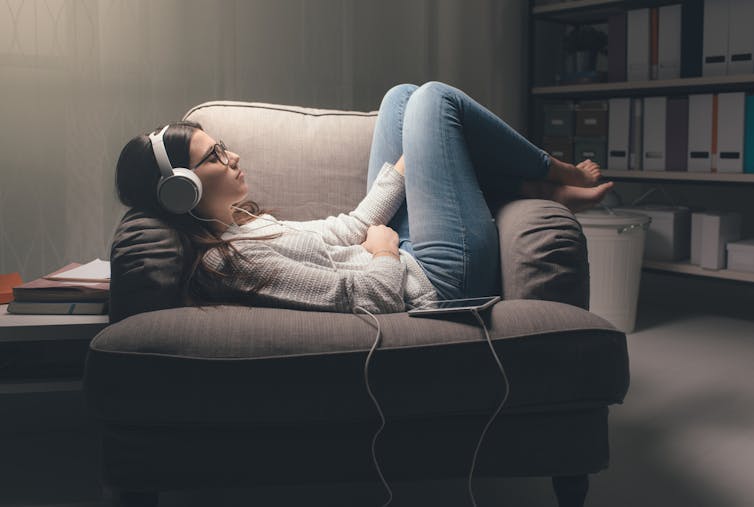Humans are intensely social creatures. We all need company and social contact. But for many of us, being at home for long periods with a small group of people – even those we love best – can become frustrating.
One key to understanding why constant contact with our family feels so unusual comes from looking at how social groups work in other primate species.
Normally, a primate’s interaction with others is very well balanced. Neither our ancestors before Homo sapiens nor our close relatives like chimpanzees and bonobos would usually live in fixed, unchanging social settings. Instead, their natural social groups are flexible, which gives them space and time to change their interactions over short time periods.
These kinds of groups, which are more complex than those of many mammals, are called multi-level or “fission-fusion” societies. They consist of an overarching group that splits up and then comes back together on an hourly, daily, or weekly basis.
Subgroups can vary in composition, with individuals coming and going. The distance that they travel away from one another can vary, as does the length of time subgroups stay together. Some, like mother-offspring groups, can last for years. Others are much shorter-lived and reflect rapidly shifting alliances, fallings out, and friendships.
This is similar to human friendship groups, some of which last for lifetimes and others for only the brief duration of a holiday.
Space to breathe
Zoos need to understand the importance of providing animals in captivity with appropriate social environments for them to thrive in. In monkeys and apes, disturbing behavior patterns resulting in psychotic behavior have been a topic of research for over 30 years. From this, it seems clear that the need for personal space and a desire to have control over the intensity and frequency of our contact with our families is not exclusive to humans.
Living in social groups is a fundamental survival strategy for primates and is one of the reasons why it’s so difficult to provide great apes with good homes in captivity.
Modern humans, meanwhile, often have the freedom to split their homes into multiple rooms and use other spaces for work and leisure. This helps us (under normal circumstances) to have a mixture of privacy, companionship, and family time. In a lockdown, of course, we have much less freedom. Social relationships that are normally maintained through a combination of intense interaction and periods of separation – while children attend school and adults go to work – now exist in close, long-term proximity.
Humans also have the most flexible and variable social networks of any primate species. Our social groups of roughly 150 individuals include “circles” of predictable sizes of successively closer people. And unlike chimpanzees, we have no firm boundaries for our groups.
A human social network is not a clear cut unit where any individual is either in or out. Instead, the boundaries are fluid, and at the edges, new people come in as others leave. Bonobos have a similar approach.
Each of our social networks also overlaps to differing degrees with others. A friend who is definitely part of my network will have their own network that overlaps with mine to a greater degree than a distant acquaintance.
For human hunter-gatherers, this sort of network structure – with close ties and distant ones, and non-overlapping connections among members of the same tribe – is vital to survival. At times of extreme stress, like a serious drought, having one or two contacts a long way away gives you somewhere to go if you can’t stay at home.
A homegroup may fission (split) for a season, with each family heading off to their distant friends, and come back together when conditions improve. The group can do this without losing their overall identity. This can also help at times of social conflict, allowing much needed time to cool off.

In essence, while we have evolved to be very sociable, we are nevertheless accustomed (culturally and evolutionarily) to flexible social networks that give us personal space to manage our lives and relationships. Both isolation and too much-enforced proximity to the same people can be detrimental to our mental health.
There is hope, however. Humans are resilient creatures who will find strategies to achieve some sense of personal space during lockdown, whether it’s through modern technology or a simple solitary stroll.
Negotiating ways for each individual in a household to control their natural need for personal space, at least some of the time, is key. Knowing that your personal time will be respected can help to ease the strain of enforced sociability.![]()
This article is republished from The Conversation by Vivien Shaw, Lecturer in Anatomy, Bangor University and Isabelle Catherine Winder, Lecturer in Zoology, Bangor University under a Creative Commons license. Read the original article.
Read next: Small errors in coronavirus testing might lead to surprisingly big problems
Corona coverage
Read our daily coverage on how the tech industry is responding to the coronavirus and subscribe to our weekly newsletter Coronavirus in Context.
For tips and tricks on working remotely, check out our Growth Quarters articles here or follow us on Twitter.
